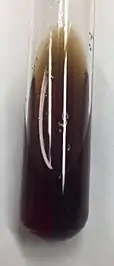 | |
| Names | |
|---|---|
| Other names
2,3,7,8,12,13,17,18-Octaethyl-21H,23H-porphine | |
| Identifiers | |
3D model (JSmol) |
|
| 379798 | |
| ChEBI | |
| ChemSpider | |
| EC Number |
|
PubChem CID |
|
| UNII | |
CompTox Dashboard (EPA) |
|
| |
| |
| Properties | |
| C36H46N4 | |
| Molar mass | 534.792 g·mol−1 |
| Appearance | purple solid |
Except where otherwise noted, data are given for materials in their standard state (at 25 °C [77 °F], 100 kPa).
Infobox references | |
Octaethylporphyrin (H2OEP) is an organic compound that is a relative of naturally occurring heme pigments. The compound is used in the preparation of models for the prosthetic group in heme proteins. It is a dark purple solid that is soluble in organic solvents. As its conjugate base OEP2-, it forms a range of transition metal porphyrin complexes. When treated with ferric chloride in hot acetic acid solution, it gives the square pyramidal complex Fe(OEP)Cl.[1] It also forms the square planar complexes Ni(OEP) and Cu(OEP).

Contrast with other porphyrins
Unlike complexes of the naturally occurring porphyrins, OEP complexes have four-fold symmetry, which simplifies spectroscopic analysis. In contrast to tetraphenylporphyrin and related analogues, H2OEP features unprotected meso positions. In this way, it is a more accurate model for naturally occurring porphyrins.
Synthesis
H2OEP is prepared by condensation of 3,4-diethylpyrrole with formaldehyde.[2]
References
- ↑ Chang, C. K.; DiNello, R. K.; Dolphin, D. (1980). "Iron Porphines". Inorg. Synth. 20: 147. doi:10.1002/9780470132517.ch35.
- ↑ Sessler, Jonathan L.; Mozaffari, Azadeh; Johnson, Martin R. (1992). "3,4-Diethylpyrrole and 2,3,7,8,12,13,17,18-Octaethylporphyrin". Org. Synth. 70: 68. doi:10.15227/orgsyn.070.0068.